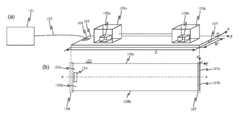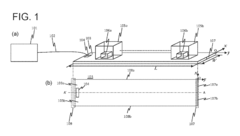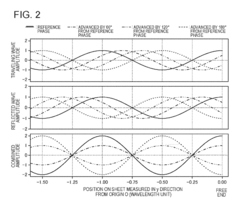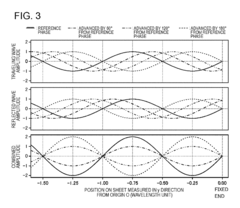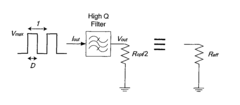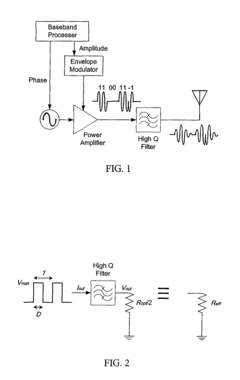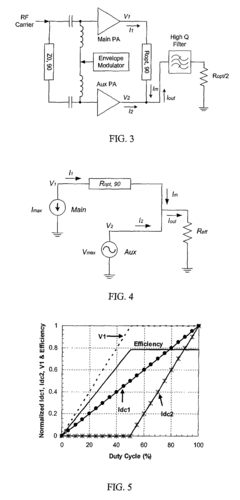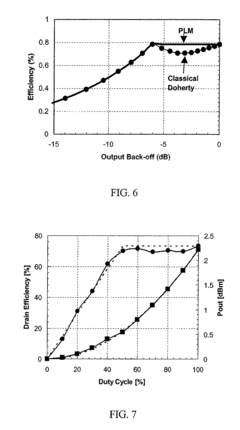How to Advance Electromagnetic Wave Modulation Techniques?
JUL 11, 20259 MIN READ
Generate Your Research Report Instantly with AI Agent
Patsnap Eureka helps you evaluate technical feasibility & market potential.
EM Wave Modulation Background and Objectives
Electromagnetic wave modulation techniques have been a cornerstone of modern communication systems since the early 20th century. The evolution of these techniques has been driven by the ever-increasing demand for faster, more efficient, and more reliable data transmission across various applications, from wireless communications to radar systems and beyond.
The field of electromagnetic wave modulation has its roots in the pioneering work of scientists like Guglielmo Marconi and Edwin Armstrong. Their early experiments with amplitude modulation (AM) and frequency modulation (FM) laid the groundwork for the development of more advanced modulation schemes. As technology progressed, digital modulation techniques such as phase-shift keying (PSK) and quadrature amplitude modulation (QAM) emerged, offering improved spectral efficiency and robustness against noise and interference.
In recent years, the rapid growth of mobile communications, Internet of Things (IoT) devices, and the impending rollout of 5G and beyond networks have pushed the boundaries of electromagnetic wave modulation techniques. The industry is now facing challenges related to spectrum scarcity, energy efficiency, and the need for higher data rates to support emerging applications like virtual reality, autonomous vehicles, and smart cities.
The primary objectives in advancing electromagnetic wave modulation techniques are multifaceted. First and foremost is the goal of increasing spectral efficiency to accommodate the growing number of connected devices and the exponential rise in data traffic. This involves developing modulation schemes that can transmit more bits per second per Hertz of bandwidth while maintaining acceptable error rates.
Another critical objective is to enhance the energy efficiency of modulation techniques. As the number of wireless devices continues to grow, reducing power consumption becomes paramount, especially for battery-operated and IoT devices. This necessitates the development of modulation schemes that can deliver high data rates with minimal power requirements.
Improving the robustness and reliability of modulation techniques in challenging environments is also a key focus. This includes developing methods to combat multipath fading, interference, and other signal distortions that can degrade communication quality. Additionally, there is a push towards creating adaptive modulation techniques that can dynamically adjust to changing channel conditions, optimizing performance in real-time.
Looking ahead, the field of electromagnetic wave modulation is poised for significant advancements. Emerging technologies such as massive MIMO (Multiple-Input Multiple-Output), beamforming, and millimeter-wave communications are opening new avenues for innovation in modulation techniques. These technologies promise to unlock higher frequency bands, enable more efficient spatial multiplexing, and pave the way for ultra-high-speed, low-latency communications.
The field of electromagnetic wave modulation has its roots in the pioneering work of scientists like Guglielmo Marconi and Edwin Armstrong. Their early experiments with amplitude modulation (AM) and frequency modulation (FM) laid the groundwork for the development of more advanced modulation schemes. As technology progressed, digital modulation techniques such as phase-shift keying (PSK) and quadrature amplitude modulation (QAM) emerged, offering improved spectral efficiency and robustness against noise and interference.
In recent years, the rapid growth of mobile communications, Internet of Things (IoT) devices, and the impending rollout of 5G and beyond networks have pushed the boundaries of electromagnetic wave modulation techniques. The industry is now facing challenges related to spectrum scarcity, energy efficiency, and the need for higher data rates to support emerging applications like virtual reality, autonomous vehicles, and smart cities.
The primary objectives in advancing electromagnetic wave modulation techniques are multifaceted. First and foremost is the goal of increasing spectral efficiency to accommodate the growing number of connected devices and the exponential rise in data traffic. This involves developing modulation schemes that can transmit more bits per second per Hertz of bandwidth while maintaining acceptable error rates.
Another critical objective is to enhance the energy efficiency of modulation techniques. As the number of wireless devices continues to grow, reducing power consumption becomes paramount, especially for battery-operated and IoT devices. This necessitates the development of modulation schemes that can deliver high data rates with minimal power requirements.
Improving the robustness and reliability of modulation techniques in challenging environments is also a key focus. This includes developing methods to combat multipath fading, interference, and other signal distortions that can degrade communication quality. Additionally, there is a push towards creating adaptive modulation techniques that can dynamically adjust to changing channel conditions, optimizing performance in real-time.
Looking ahead, the field of electromagnetic wave modulation is poised for significant advancements. Emerging technologies such as massive MIMO (Multiple-Input Multiple-Output), beamforming, and millimeter-wave communications are opening new avenues for innovation in modulation techniques. These technologies promise to unlock higher frequency bands, enable more efficient spatial multiplexing, and pave the way for ultra-high-speed, low-latency communications.
Market Demand for Advanced Modulation Techniques
The market demand for advanced electromagnetic wave modulation techniques has been steadily increasing across various sectors, driven by the growing need for higher data rates, improved spectral efficiency, and enhanced communication reliability. In the telecommunications industry, the rapid expansion of 5G networks and the impending development of 6G technologies have created a significant demand for more sophisticated modulation schemes. These advanced techniques are crucial for accommodating the exponential growth in mobile data traffic and supporting emerging applications such as augmented reality, virtual reality, and the Internet of Things (IoT).
The aerospace and defense sectors also exhibit a strong demand for advanced modulation techniques. Military communications require robust and secure transmission methods that can operate in challenging environments and resist jamming attempts. Similarly, satellite communications benefit from advanced modulation schemes to maximize data throughput over limited bandwidth and overcome signal degradation due to long-distance transmission.
In the broadcasting industry, the transition to digital television and radio has spurred the adoption of more efficient modulation techniques. These advancements allow broadcasters to deliver higher quality content, including 4K and 8K video, while optimizing spectrum usage. The automotive industry is another emerging market for advanced modulation techniques, particularly in the development of vehicle-to-everything (V2X) communication systems for autonomous vehicles.
The industrial sector is increasingly adopting wireless technologies for automation and control systems, creating a demand for modulation techniques that can provide reliable communication in harsh electromagnetic environments. Smart grid applications in the energy sector also require robust modulation schemes to ensure reliable data transmission for efficient power distribution and management.
Market analysts project substantial growth in the global market for advanced modulation technologies. This growth is fueled by the increasing adoption of software-defined radio (SDR) systems, which allow for flexible implementation of various modulation schemes. Additionally, the ongoing research and development in quantum communication systems are expected to create new opportunities for advanced modulation techniques in the coming years.
However, the market demand is not without challenges. The implementation of advanced modulation techniques often requires significant investments in infrastructure upgrades and new equipment. There is also a growing need for skilled professionals who can design, implement, and maintain these sophisticated systems. Furthermore, regulatory bodies must keep pace with technological advancements to ensure efficient spectrum allocation and usage.
The aerospace and defense sectors also exhibit a strong demand for advanced modulation techniques. Military communications require robust and secure transmission methods that can operate in challenging environments and resist jamming attempts. Similarly, satellite communications benefit from advanced modulation schemes to maximize data throughput over limited bandwidth and overcome signal degradation due to long-distance transmission.
In the broadcasting industry, the transition to digital television and radio has spurred the adoption of more efficient modulation techniques. These advancements allow broadcasters to deliver higher quality content, including 4K and 8K video, while optimizing spectrum usage. The automotive industry is another emerging market for advanced modulation techniques, particularly in the development of vehicle-to-everything (V2X) communication systems for autonomous vehicles.
The industrial sector is increasingly adopting wireless technologies for automation and control systems, creating a demand for modulation techniques that can provide reliable communication in harsh electromagnetic environments. Smart grid applications in the energy sector also require robust modulation schemes to ensure reliable data transmission for efficient power distribution and management.
Market analysts project substantial growth in the global market for advanced modulation technologies. This growth is fueled by the increasing adoption of software-defined radio (SDR) systems, which allow for flexible implementation of various modulation schemes. Additionally, the ongoing research and development in quantum communication systems are expected to create new opportunities for advanced modulation techniques in the coming years.
However, the market demand is not without challenges. The implementation of advanced modulation techniques often requires significant investments in infrastructure upgrades and new equipment. There is also a growing need for skilled professionals who can design, implement, and maintain these sophisticated systems. Furthermore, regulatory bodies must keep pace with technological advancements to ensure efficient spectrum allocation and usage.
Current Challenges in EM Wave Modulation
Electromagnetic wave modulation techniques face several significant challenges in their current state of development. One of the primary issues is the increasing demand for higher data rates and spectral efficiency in wireless communications. As the electromagnetic spectrum becomes more crowded, there is a pressing need for advanced modulation schemes that can transmit more information within limited bandwidth.
Another challenge lies in the complexity of implementing sophisticated modulation techniques in practical systems. As modulation schemes become more intricate to achieve higher performance, they often require more complex hardware and signal processing algorithms. This complexity can lead to increased power consumption, larger form factors, and higher costs, which are particularly problematic for mobile and IoT devices.
The effects of channel impairments and interference pose ongoing challenges for EM wave modulation. Multipath fading, Doppler shift, and various forms of noise can significantly degrade signal quality and reliability. Developing robust modulation techniques that can maintain performance under adverse channel conditions remains a critical area of research.
In the realm of 5G and beyond, there is a growing need for modulation techniques that can support massive MIMO systems and beamforming technologies. These advanced antenna configurations require modulation schemes that can effectively utilize spatial diversity and adapt to rapidly changing channel conditions.
Energy efficiency is another major concern, particularly for battery-powered devices and large-scale communication infrastructure. Modulation techniques that can deliver high data rates while minimizing power consumption are in high demand, but achieving this balance is technically challenging.
The push towards higher frequency bands, such as millimeter-wave and terahertz communications, introduces new challenges for modulation. These frequencies offer vast bandwidth but suffer from severe path loss and atmospheric absorption, necessitating novel modulation approaches that can overcome these physical limitations.
Lastly, the increasing importance of security in wireless communications presents challenges for modulation techniques. There is a growing need for modulation schemes that inherently enhance the physical layer security of transmissions, making them more resistant to eavesdropping and jamming attacks.
Another challenge lies in the complexity of implementing sophisticated modulation techniques in practical systems. As modulation schemes become more intricate to achieve higher performance, they often require more complex hardware and signal processing algorithms. This complexity can lead to increased power consumption, larger form factors, and higher costs, which are particularly problematic for mobile and IoT devices.
The effects of channel impairments and interference pose ongoing challenges for EM wave modulation. Multipath fading, Doppler shift, and various forms of noise can significantly degrade signal quality and reliability. Developing robust modulation techniques that can maintain performance under adverse channel conditions remains a critical area of research.
In the realm of 5G and beyond, there is a growing need for modulation techniques that can support massive MIMO systems and beamforming technologies. These advanced antenna configurations require modulation schemes that can effectively utilize spatial diversity and adapt to rapidly changing channel conditions.
Energy efficiency is another major concern, particularly for battery-powered devices and large-scale communication infrastructure. Modulation techniques that can deliver high data rates while minimizing power consumption are in high demand, but achieving this balance is technically challenging.
The push towards higher frequency bands, such as millimeter-wave and terahertz communications, introduces new challenges for modulation. These frequencies offer vast bandwidth but suffer from severe path loss and atmospheric absorption, necessitating novel modulation approaches that can overcome these physical limitations.
Lastly, the increasing importance of security in wireless communications presents challenges for modulation techniques. There is a growing need for modulation schemes that inherently enhance the physical layer security of transmissions, making them more resistant to eavesdropping and jamming attacks.
Existing EM Wave Modulation Solutions
01 Amplitude Modulation Techniques
Amplitude modulation is a fundamental technique in electromagnetic wave modulation where the amplitude of the carrier wave is varied in proportion to the message signal. This method is widely used in radio broadcasting and communication systems due to its simplicity and effectiveness in transmitting information over long distances.- Amplitude Modulation Techniques: Amplitude modulation is a fundamental technique in electromagnetic wave modulation where the amplitude of a carrier wave is varied in proportion to the message signal. This method is widely used in radio broadcasting and communication systems. It includes variants such as single-sideband modulation and quadrature amplitude modulation, which offer improved spectral efficiency and signal-to-noise ratio.
- Frequency Modulation Methods: Frequency modulation involves varying the frequency of the carrier wave according to the message signal. This technique provides better noise immunity compared to amplitude modulation and is commonly used in FM radio broadcasting and wireless communication systems. Advanced forms of frequency modulation include phase-locked loop systems and frequency-shift keying for digital communications.
- Digital Modulation Schemes: Digital modulation techniques convert digital data into analog signals for transmission. These methods include phase-shift keying (PSK), frequency-shift keying (FSK), and quadrature amplitude modulation (QAM). These techniques are crucial in modern digital communication systems, offering high data rates, spectral efficiency, and robustness against noise and interference.
- Optical Modulation Techniques: Optical modulation involves manipulating light waves to carry information. This includes techniques such as intensity modulation, phase modulation, and polarization modulation. These methods are essential in fiber-optic communication systems, enabling high-speed data transmission over long distances with minimal signal degradation.
- Advanced Modulation and Multiplexing: Advanced modulation techniques combine multiple modulation methods or incorporate sophisticated signal processing. This category includes orthogonal frequency-division multiplexing (OFDM), which is widely used in wireless broadband systems, and adaptive modulation schemes that adjust parameters based on channel conditions. These techniques aim to maximize spectral efficiency, data rate, and reliability in challenging communication environments.
02 Frequency Modulation Methods
Frequency modulation involves varying the frequency of the carrier wave according to the message signal. This technique offers improved noise resistance compared to amplitude modulation and is commonly used in FM radio broadcasting, wireless communication systems, and radar applications.Expand Specific Solutions03 Phase Modulation Techniques
Phase modulation alters the phase of the carrier wave in response to the message signal. This method is often used in digital communication systems, offering high data rates and efficient spectrum utilization. It forms the basis for many modern wireless communication standards.Expand Specific Solutions04 Digital Modulation Schemes
Digital modulation techniques convert digital data into analog signals for transmission. These methods include various forms of keying such as Phase Shift Keying (PSK), Frequency Shift Keying (FSK), and Quadrature Amplitude Modulation (QAM). They are essential in modern digital communication systems, offering high data rates and spectral efficiency.Expand Specific Solutions05 Advanced Modulation Techniques for Optical Communications
Advanced modulation techniques are being developed for optical communication systems to increase data transmission rates and improve spectral efficiency. These include coherent optical modulation schemes and multi-level modulation formats, which are crucial for high-capacity fiber-optic networks and long-distance data transmission.Expand Specific Solutions
Key Players in EM Wave Modulation Industry
The electromagnetic wave modulation techniques field is in a mature stage of development, with ongoing research and innovation. The market size is substantial, driven by applications in telecommunications, wireless networks, and emerging technologies like 5G. Technologically, the field is well-established but continues to evolve. Key players like Huawei, Nokia, and university research centers such as the University of Electronic Science & Technology of China and the University of Tokyo are at the forefront of advancing these techniques. Companies like NETGEAR and Deutsche Telekom are also significant contributors, applying these technologies in consumer and enterprise products. The competitive landscape is characterized by a mix of established telecommunications giants, specialized equipment manufacturers, and academic institutions pushing the boundaries of electromagnetic wave modulation.
Huawei Technologies Co., Ltd.
Technical Solution: Huawei has developed advanced electromagnetic wave modulation techniques for 5G and beyond. They have implemented Massive MIMO (Multiple-Input Multiple-Output) technology, which uses large antenna arrays to focus energy in specific directions, improving spectral efficiency and reducing interference[1]. Huawei has also pioneered polar coding, a breakthrough in channel coding that enhances data transmission reliability in challenging environments[2]. Their research extends to Terahertz communication, exploring frequencies above 100 GHz for ultra-high-speed, short-range data transfer[3]. Additionally, Huawei is working on cognitive radio technologies that allow dynamic spectrum access, optimizing the use of available frequency bands[4].
Strengths: Strong R&D capabilities, leadership in 5G technology, and innovative approaches to spectrum efficiency. Weaknesses: Potential geopolitical challenges affecting global market access and technology partnerships.
Fraunhofer-Gesellschaft eV
Technical Solution: Fraunhofer-Gesellschaft has been at the forefront of research in electromagnetic wave modulation techniques. They have developed advanced signal processing algorithms for massive MIMO systems, improving spectral efficiency and reducing inter-cell interference[17]. Fraunhofer's research includes work on terahertz communications, exploring novel modulation schemes for ultra-high-frequency bands[18]. They are also investigating visible light communication (VLC) technologies, which use rapid modulation of LED lights to transmit data, offering a potential alternative to radio frequency communications in certain scenarios[19]. Additionally, Fraunhofer is working on adaptive modulation and coding techniques that can optimize transmission parameters based on channel conditions, enhancing overall system performance[20].
Strengths: Strong focus on applied research, extensive collaboration with industry partners, and broad expertise across multiple technological domains. Weaknesses: As a research organization, may face challenges in directly competing with commercial entities in product development and market deployment.
Core Innovations in Modulation Techniques
Electromagnetic wave transmission sheet and electromagnetic wave transmission device
PatentInactiveUS9853501B2
Innovation
- The electromagnetic wave transmission device features a sheet with long and short end sides, where the short end sides are divided into portions acting as reflection terminals, with the positions of the antinodes of the standing waves deviated by ¼ of the wavelength, allowing for the reception of power from both standing wave groups and mitigating non-uniformity by configuring the sheet without electromagnetic wave absorbing media on the end sides.
Pulsed load modulation amplifier and method
PatentInactiveUS8254854B2
Innovation
- The proposed pulsed load modulation (PLM) technique uses a digital pulsed approach to control load impedance by separating RF signals into carrier and data paths, digitizing the data signal, and switching amplifier gates to maintain maximum efficiency over a wide range of power levels, employing a high-Q bandpass filter and switched resonator configuration to achieve optimal efficiency and linearity.
Spectrum Efficiency and Regulatory Considerations
Spectrum efficiency and regulatory considerations play a crucial role in advancing electromagnetic wave modulation techniques. As the demand for wireless communication continues to grow exponentially, the efficient utilization of the limited radio frequency spectrum becomes increasingly important. Spectrum efficiency refers to the ability to transmit more information within a given bandwidth, which is essential for accommodating the ever-increasing data traffic and supporting emerging technologies such as 5G and beyond.
To enhance spectrum efficiency, advanced modulation techniques are being developed and implemented. These techniques aim to increase the number of bits transmitted per Hertz of bandwidth while maintaining acceptable levels of signal quality and reliability. Some of the promising approaches include higher-order modulation schemes, such as 256-QAM and 1024-QAM, which can transmit more bits per symbol. Additionally, multi-carrier modulation techniques like OFDM (Orthogonal Frequency Division Multiplexing) and its variants are widely used to improve spectral efficiency by dividing the available bandwidth into multiple subcarriers.
Regulatory considerations are equally important in the advancement of electromagnetic wave modulation techniques. Regulatory bodies, such as the Federal Communications Commission (FCC) in the United States and the European Telecommunications Standards Institute (ETSI) in Europe, play a vital role in managing and allocating spectrum resources. These organizations establish guidelines and standards for spectrum usage, including permissible modulation schemes, power levels, and interference mitigation techniques.
The regulatory landscape is evolving to accommodate new technologies and promote efficient spectrum utilization. For instance, dynamic spectrum access and cognitive radio technologies are being explored to enable more flexible and efficient use of the available spectrum. These approaches allow for opportunistic access to underutilized frequency bands, potentially increasing overall spectrum efficiency.
Furthermore, regulatory bodies are considering the allocation of higher frequency bands, such as millimeter-wave frequencies, to support advanced modulation techniques and high-bandwidth applications. This shift towards higher frequencies presents both opportunities and challenges for modulation techniques, as it allows for increased data rates but also requires addressing issues related to signal propagation and attenuation.
As electromagnetic wave modulation techniques continue to advance, close collaboration between researchers, industry stakeholders, and regulatory bodies is essential. This collaboration ensures that new modulation schemes and technologies comply with regulatory requirements while maximizing spectrum efficiency. It also helps in addressing potential interference issues and ensuring the coexistence of different wireless systems operating in adjacent frequency bands.
To enhance spectrum efficiency, advanced modulation techniques are being developed and implemented. These techniques aim to increase the number of bits transmitted per Hertz of bandwidth while maintaining acceptable levels of signal quality and reliability. Some of the promising approaches include higher-order modulation schemes, such as 256-QAM and 1024-QAM, which can transmit more bits per symbol. Additionally, multi-carrier modulation techniques like OFDM (Orthogonal Frequency Division Multiplexing) and its variants are widely used to improve spectral efficiency by dividing the available bandwidth into multiple subcarriers.
Regulatory considerations are equally important in the advancement of electromagnetic wave modulation techniques. Regulatory bodies, such as the Federal Communications Commission (FCC) in the United States and the European Telecommunications Standards Institute (ETSI) in Europe, play a vital role in managing and allocating spectrum resources. These organizations establish guidelines and standards for spectrum usage, including permissible modulation schemes, power levels, and interference mitigation techniques.
The regulatory landscape is evolving to accommodate new technologies and promote efficient spectrum utilization. For instance, dynamic spectrum access and cognitive radio technologies are being explored to enable more flexible and efficient use of the available spectrum. These approaches allow for opportunistic access to underutilized frequency bands, potentially increasing overall spectrum efficiency.
Furthermore, regulatory bodies are considering the allocation of higher frequency bands, such as millimeter-wave frequencies, to support advanced modulation techniques and high-bandwidth applications. This shift towards higher frequencies presents both opportunities and challenges for modulation techniques, as it allows for increased data rates but also requires addressing issues related to signal propagation and attenuation.
As electromagnetic wave modulation techniques continue to advance, close collaboration between researchers, industry stakeholders, and regulatory bodies is essential. This collaboration ensures that new modulation schemes and technologies comply with regulatory requirements while maximizing spectrum efficiency. It also helps in addressing potential interference issues and ensuring the coexistence of different wireless systems operating in adjacent frequency bands.
Energy Efficiency in Modulation Systems
Energy efficiency has become a critical concern in electromagnetic wave modulation systems, driven by the increasing demand for high-performance communication networks and the need to reduce power consumption. The pursuit of energy-efficient modulation techniques is essential for sustainable development in the telecommunications industry and aligns with global efforts to minimize environmental impact.
Current modulation systems face challenges in balancing performance with energy consumption. Traditional modulation schemes often prioritize data rates and spectral efficiency at the expense of power efficiency. However, recent advancements in modulation techniques have shown promising results in improving energy efficiency without compromising system performance.
One approach to enhancing energy efficiency is through the development of adaptive modulation schemes. These systems dynamically adjust modulation parameters based on channel conditions, allowing for optimal power allocation and reduced energy waste. By adapting to real-time signal quality and environmental factors, these systems can maintain high data rates while minimizing unnecessary power consumption.
Another area of focus is the implementation of low-power modulation techniques. These methods aim to reduce the overall energy requirements of the modulation process by optimizing signal processing algorithms and hardware designs. Techniques such as constant envelope modulation and single-carrier frequency division multiple access (SC-FDMA) have shown significant improvements in power efficiency, particularly in mobile and IoT applications.
The integration of energy harvesting technologies with modulation systems presents an innovative approach to improving overall energy efficiency. By capturing and utilizing ambient energy sources, such as electromagnetic waves or thermal gradients, these systems can supplement their power requirements and reduce dependence on external energy sources. This approach is particularly promising for remote or low-power communication devices.
Advanced signal processing techniques, including compressive sensing and sparse signal reconstruction, are being explored to reduce the computational complexity of modulation systems. By minimizing the number of required operations and optimizing resource allocation, these techniques can significantly reduce power consumption in both transmitters and receivers.
The development of energy-efficient modulation systems also involves advancements in hardware design. The use of low-power components, such as energy-efficient amplifiers and digital signal processors, contributes to overall system efficiency. Additionally, the integration of power management circuits and sleep mode capabilities allows for intelligent power conservation during periods of low activity.
As research in this field progresses, the focus is shifting towards holistic approaches that consider energy efficiency across the entire communication system. This includes optimizing not only the modulation scheme but also the network architecture, routing protocols, and resource allocation strategies. By addressing energy efficiency at multiple levels, significant improvements in overall system performance and sustainability can be achieved.
Current modulation systems face challenges in balancing performance with energy consumption. Traditional modulation schemes often prioritize data rates and spectral efficiency at the expense of power efficiency. However, recent advancements in modulation techniques have shown promising results in improving energy efficiency without compromising system performance.
One approach to enhancing energy efficiency is through the development of adaptive modulation schemes. These systems dynamically adjust modulation parameters based on channel conditions, allowing for optimal power allocation and reduced energy waste. By adapting to real-time signal quality and environmental factors, these systems can maintain high data rates while minimizing unnecessary power consumption.
Another area of focus is the implementation of low-power modulation techniques. These methods aim to reduce the overall energy requirements of the modulation process by optimizing signal processing algorithms and hardware designs. Techniques such as constant envelope modulation and single-carrier frequency division multiple access (SC-FDMA) have shown significant improvements in power efficiency, particularly in mobile and IoT applications.
The integration of energy harvesting technologies with modulation systems presents an innovative approach to improving overall energy efficiency. By capturing and utilizing ambient energy sources, such as electromagnetic waves or thermal gradients, these systems can supplement their power requirements and reduce dependence on external energy sources. This approach is particularly promising for remote or low-power communication devices.
Advanced signal processing techniques, including compressive sensing and sparse signal reconstruction, are being explored to reduce the computational complexity of modulation systems. By minimizing the number of required operations and optimizing resource allocation, these techniques can significantly reduce power consumption in both transmitters and receivers.
The development of energy-efficient modulation systems also involves advancements in hardware design. The use of low-power components, such as energy-efficient amplifiers and digital signal processors, contributes to overall system efficiency. Additionally, the integration of power management circuits and sleep mode capabilities allows for intelligent power conservation during periods of low activity.
As research in this field progresses, the focus is shifting towards holistic approaches that consider energy efficiency across the entire communication system. This includes optimizing not only the modulation scheme but also the network architecture, routing protocols, and resource allocation strategies. By addressing energy efficiency at multiple levels, significant improvements in overall system performance and sustainability can be achieved.
Unlock deeper insights with Patsnap Eureka Quick Research — get a full tech report to explore trends and direct your research. Try now!
Generate Your Research Report Instantly with AI Agent
Supercharge your innovation with Patsnap Eureka AI Agent Platform!
